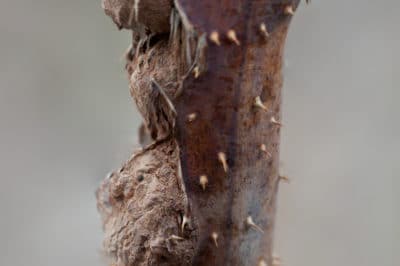Prevention of Disease
Raspberry bushes are susceptible to diseases that can be fatal, but most of the diseases can be controlled or prevented. Here are some preventative steps that may save your raspberry crop:
- Purchase canes from disease-free nurseries.
- Raspberry plants should not be grown in soil that is overly moist.
- Do not plant canes in soil that recently grew roses, wild berries, tomatoes, potatoes, or peppers.
- Control aphids and other pests.
- Disinfect pruning tools between uses.
Agrobacterium
Agrobacterium tumefaciens is a bacteria that produces galls on the crown of a raspberry plant. The soft, round, tan gall becomes black, irregular, rough, and corky. Plants may wilt, be stunted, or die from this bacteria.
Agrobacterium usually enters the raspberry through a fresh wound or natural opening. It can survive in soil and diseased tissue for years. The bacteria are spread by rain splash.
Fire Blight and Bacterial Blight
Significant browning of raspberry canes and burnt-looking stems and leaves may be caused by the bacterial diseases fire blight or bacterial blight. Disease enters the plant through an open wound or pruning cut. To prevent the spreading of the disease, cut out the diseased plant material 12 inches or more below the infected area. Destroy this diseased plant material.
Anthracnose
Anthracnose is a fungal disease that causes the raspberry canes to turn brown. In the internodes of the canes or stems, sunken white to tan pits develop. Reddish-purple margins often circle these 1/4 inch or smaller pits. Anthracnose causes the canes to crack, weaken, and often die during the winter.
Spur Blight
Spur blight is a fungal disease that begins in the leaves or at the node where the leaf is attached to the cane. Purple or brown 1/2 inch spots appear around the nodes. Leaves will become yellow and brown, die, and fall off. Spur blight will cause the infected areas to become non-productive.
Cane Blight
Cane blight is a fungal disease that begins in primocane wound sites. A wound may begin after tip pruning or if the primocanes rub against a trellis wire or each other. This fungal infection causes cankers to form on the cane, sometimes encircling it. Early in the infection, the cankers are reddish-brown under the bark.
The cankers can cause leaves in the infected area to wilt then die. An entire cane may wilt and die if the cankers encircle it.
